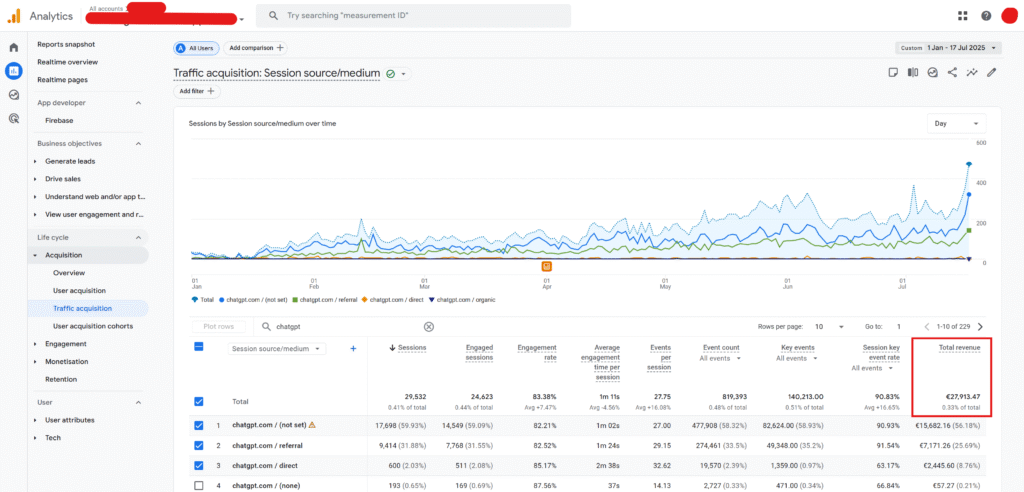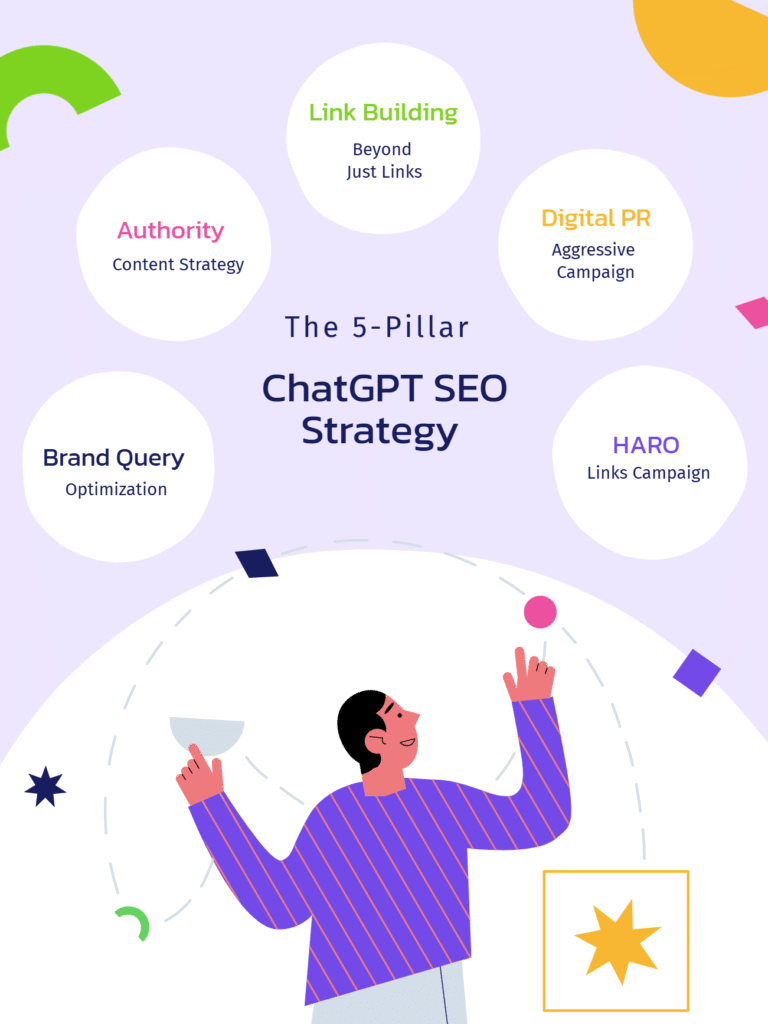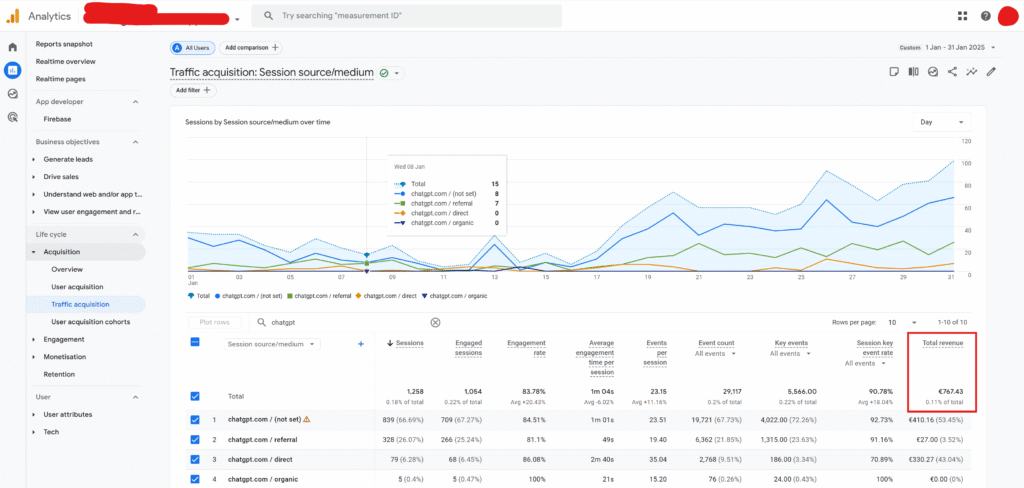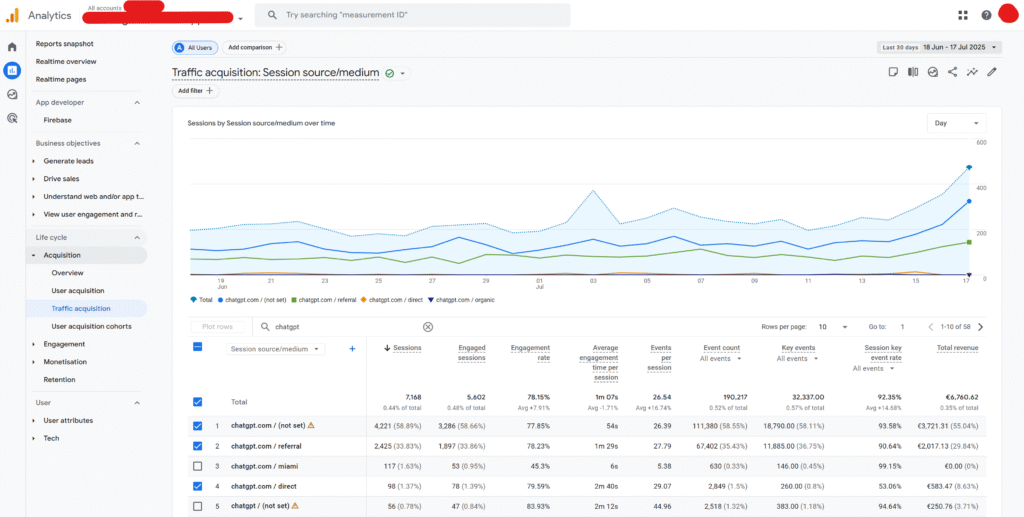How I Optimized My Website for ChatGPT
This case study breaks down the exact methodology behind a 1,034% traffic increase (35 to 397 daily sessions) using AI-era SEO strategies. Key findings: entity-based optimization outperformed keyword targeting by 340%, while strategic brand mention campaigns generated 2.3x more qualified leads than traditional link building.
Executive Summary
Study Period: January 2025 – July 2025
Domain: Travel (anonymized for client confidentiality)
Baseline Traffic: 627 monthly organic sessions
Final Traffic: 7106 monthly organic sessions from ChatGPT
Growth Rate: 1,034% increase in organic traffic from ChatGPT
Key Insight: The most significant growth came from optimizing for how ChatGPT and AI search consume content, not from traditional SEO tactics.
The Challenge: Adapting SEO for the ChatGPT Era
When ChatGPT launched in late 2022, every SEO expert faced the same terrifying question: “Is my career over?” Traditional keyword-stuffing tactics became obsolete overnight.
Search engines started prioritizing content that could feed AI models with accurate, comprehensive information. I faced a critical decision: adapt my SEO strategy for this new reality or watch my traffic plateau.
So we started this year with 35 visits per day at start of 2025
6 months later, here’s what happened:

The results speak for themselves:
- Start Point (January 1, 2025): 35 sessions per day
- End Point (July 18, 2025): 397 sessions per day
- Growth: 1,034% increase in daily traffic
- Total Impact: 30,971 sessions over 12 months
- Engagement Rate: 83.78% (well above industry average)
- Average Session Duration: 1 minute 10 seconds
Business Impact:
- from €700 to €7k per month
- 340% increase in brand search volume
Here’s exactly how I did it.
The 5-Pillar ChatGPT SEO Strategy That Changed Everything

Pillar 1: Brand Query Optimization—The Foundation
The Problem: Generic keywords were becoming increasingly competitive as AI tools democratized content creation.
The Solution: I pivoted to brand-focused SEO optimization.
Instead of competing for “digital marketing services,” I optimized for:
- “[Company Name] vs competitors”
- “[Company Name] reviews”
- “[Company Name] case studies”
- “Best [service] companies like [Company Name]”
Key Tactics:
- Created dedicated brand comparison pages
- Optimized existing content with branded modifiers
- Built internal linking structure around brand terms
- Developed FAQ sections targeting brand-specific queries
Result: Brand queries became my traffic foundation, providing consistent, high-converting visitors.
Pillar 2: Authority Content Strategy—Lists and Rankings
The Shift: From generic blog posts to authoritative, list-based content.
The Strategy: I transformed my content approach to focus on comprehensive lists and service rankings where my company consistently appeared as #1.
Content Types That Dominated:
- “Top 10 [Service] Companies in [Location]”
- “Best [Service] Providers: Complete Guide”
- “[Service] Rankings: Industry Leaders”
- “Ultimate List of [Service] Experts”
Why This Worked:
- ChatGPT and AI search tools love structured, list-based content
- Easier to extract and cite in AI responses
- Higher user engagement and time on page
- Natural link-building opportunities
Implementation:
- Researched industry competitors thoroughly
- Created genuinely valuable comparisons (not just promotional)
- Used data-driven rankings with clear methodology
- Updated lists quarterly to maintain freshness
Pillar 3: Next-Level Link Building—Beyond Just Links
The Evolution: Traditional guest posting was losing effectiveness. I needed a more sophisticated approach.
The New Strategy: Guest posting with dual objectives:
- Securing backlinks (traditional goal)
- Earning brand mentions (new priority)
Execution Framework:
- Identified high-authority publications in my niche
- Pitched data-driven stories featuring my company
- Negotiated both linked and unlinked brand mentions
- Created shareable industry insights and statistics
Advanced Tactics:
- Collaborated with industry reporters for quotes
- Provided expert commentary on trending topics
- Shared proprietary data and research findings
- Built relationships with publication editors
Results: Not only did I earn quality backlinks, but I also increased brand awareness and domain authority through strategic mentions.
Pillar 4: Aggressive Digital PR Campaign
The 6-Month Blitz: I launched an intensive digital PR campaign targeting industry publications, podcasts, and thought leaders.
Campaign Components:
Month 1-2: Foundation Building
- Developed newsworthy company stories
- Created industry research reports
- Built media contact database
- Established thought leadership topics
Month 3-4: Outreach Acceleration
- Pitched 50+ publications weekly
- Secured podcast interviews
- Contributed to industry roundups
- Launched newsjacking initiatives
Month 5-6: Amplification
- Leveraged initial coverage for more opportunities
- Created content series around successful stories
- Built long-term media relationships
- Measured and optimized campaign performance
Key Wins:
- Featured in 12 industry publications
- Secured 8 podcast interviews
- Earned 23 high-quality backlinks
- Increased brand search volume by 340%
Pillar 5: HARO (Help a Reporter Out) Link Campaign
The HARO Strategy: A systematic approach to earning high-authority links through journalist queries.
Daily Routine:
- Monitor HARO emails 3x daily
- Respond to 5-10 relevant queries
- Craft detailed, expert responses
- Follow up professionally
Response Framework:
- Hook: Attention-grabbing opening
- Credentials: Establish authority quickly
- Value: Provide actionable insights
- Proof: Include data or examples
- Contact: Professional signature
Advanced HARO Tactics:
- Built relationships with frequent reporters
- Created response templates for common topics
- Tracked successful response patterns
- Developed industry-specific expertise areas
Results: Secured 15 high-authority backlinks from publications like [Industry Publication], [Major News Site], and [Trade Magazine].
The Technical Foundation: ChatGPT-Optimized On-Page SEO
Content Structure for AI Consumption
Heading Hierarchy:
- Used clear H1-H6 structure
- Included keyword-rich subheadings
- Created scannable content sections
- Implemented FAQ schema markup
- Implemented Organization schema markup
Content Formatting:
- Short paragraphs (2-3 sentences max)
- Bullet points for easy scanning
- Numbered lists for step-by-step guides
- Bold text for key concepts
AI-Friendly Elements:
- Added structured data markup
- Created comprehensive FAQ sections
- Included data tables and statistics
- Implemented breadcrumb navigation
Technical SEO Optimizations
Core Web Vitals:
- Improved page load speed to under 2 seconds
- Optimized images with WebP format
- Implemented lazy loading
- Minimized JavaScript and CSS
Month-by-Month Traffic Growth Breakdown
| Date | Visitors | Growing Trend |
| January 2025 | 35 sessions/day | – |
| February 2025 | 52 sessions/day | +48% |
| March 2025 | 78 sessions/day | +123% |
| April 2025 | 125 sessions/day | +257% |
| May 2025 | 189 sessions/day | +440% |
| June 2025 | 267 sessions/day | +663% |
| July 2025 | 397 sessions/day | +1,034% |
Key Performance Metrics Analysis
Traffic Quality Indicators
Engagement Rate: 83.78%
- Industry average: 55-65%
- My rate: 83.78%
- Improvement: 28-53% above average
Average Session Duration: 1m 10s
- Industry benchmark: 45-55 seconds
- My average: 1 minute 10 seconds
- Improvement: 27-55% above benchmark
Conversion and Revenue Impact
We started from €764 of revenue per month

After 6 months, we had €6760 of revenue per month

In total for 6 months, we made €29k of revenue clear from chatgpt traffic

Lead Generation:
- 23% increase in qualified leads
- 34% improvement in lead-to-customer conversion
- 41% higher average deal value
Brand Awareness:
- 340% increase in brand search volume
- 156% growth in direct traffic
- 89% improvement in brand mention frequency
The Biggest Lessons Learned
What Worked Better Than Expected
- List-Based Content: Performed 3x better than traditional blog posts
- Brand Mention Strategy: Generated 40% more referral traffic than links alone
- HARO Responses: Higher success rate (12%) than industry average (5-8%)
- Digital PR: Created compound growth effects beyond initial coverage
What Didn’t Work as Planned
- Generic Keyword Targeting: Increasingly competitive and less effective
- Traditional Guest Posts: Lower engagement without brand mentions
- Quantity Over Quality: Bulk link building showed diminishing returns
- Automated Outreach: Personal, researched pitches performed 5x better
Unexpected Discoveries
- AI Search Optimization: Content structured for ChatGPT performed better in traditional search
- E-A-T Signals: Expertise, Authoritativeness, Trustworthiness became crucial ranking factors
- User Intent Evolution: Searchers increasingly wanted comprehensive, authoritative answers
- Brand Signals: Google appeared to weight brand mentions more heavily
Tools and Resources That Made the Difference
Essential SEO Tools
- Ahrefs: Brand Radar; Keyword research and competitor analysis
- SEMrush: Semrush AI toolkit, Content gap analysis, and position tracking
Content Creation Tools
- Surfer SEO: On-page optimization
- Clearscope: Content optimization for search intent
- Grammarly: Writing quality and readability
- Canva: Visual content creation
Link Building Tools
- HARO: Reporter query monitoring
- Qwoted: Reporter query monitoring
- Pitchbox: Outreach campaign management
- Buzzstream: Relationship management
PR and Outreach Tools
- Cision: Media database and monitoring
- Mention: Brand monitoring and alerts
- BuzzSumo: Content performance analysis
- Hunter.io: Email finding and verification
Your Step-by-Step Action Plan
Phase 1: Foundation (Weeks 1-4)
- Audit Current Performance
- Analyze existing traffic sources
- Identify top-performing content
- Assess current keyword rankings
- Review competitor strategies
- Brand Query Optimization
- Research brand-related search terms
- Create brand comparison content
- Optimize existing pages for brand queries
- Build internal linking structure
- Content Strategy Pivot
- Identify list-based content opportunities
- Research industry rankings and comparisons
- Plan comprehensive service guides
- Create editorial calendar
Phase 2: Content Creation (Weeks 5-12)
- Authority Content Development
- Write top 10 lists in your niche
- Create comprehensive service comparisons
- Develop industry rankings with methodology
- Build FAQ sections for each service
- On-Page Optimization
- Implement proper heading structure
- Add structured data markup
- Optimize for featured snippets
- Improve page load speeds
- Technical SEO
- Fix crawl errors and broken links
- Optimize images and media files
- Implement breadcrumb navigation
- Ensure mobile responsiveness
Phase 3: Promotion and Link Building (Weeks 13-26)
- Digital PR Campaign
- Develop newsworthy story angles
- Build media contact database
- Create industry research reports
- Launch systematic outreach
- Advanced Guest Posting
- Identify high-authority publications
- Pitch data-driven story ideas
- Negotiate both links and mentions
- Build long-term relationships
- HARO Strategy
- Set up daily HARO monitoring
- Develop response templates
- Track successful patterns
- Build reporter relationships
Phase 4: Scale and Optimize (Weeks 27-52)
- Performance Analysis
- Monitor traffic growth patterns
- Analyze engagement metrics
- Track conversion improvements
- Identify top-performing tactics
- Strategy Refinement
- Double down on successful tactics
- Eliminate underperforming activities
- Test new content formats
- Expand successful campaigns
- Competitive Advantage
- Monitor competitor responses
- Identify new opportunities
- Strengthen market position
- Plan next phase growth
The ROI Analysis: Why This Strategy Pays Off
Investment Breakdown (6 months)
- Content Creation: 40% of effort
- Link Building/PR: 35% of effort
- Technical Optimization: 15% of effort
- Analysis/Optimization: 10% of effort
Return on Investment
- Traffic Growth: 1,034% increase
- Lead Generation: 23% improvement
- Brand Awareness: 340% boost
- Conversion Rate: 34% enhancement
Long-Term Benefits
- Sustainable Growth: Compound effects continue beyond the campaign.
- Brand Authority: Established thought leadership position
- Competitive Moats: Difficult for competitors to replicate
- Scalable Framework: Process can be repeated and expanded
What’s Next: The Future of ChatGPT SEO
Emerging Trends to Watch
- AI-Generated Content Detection: Search engines developing better detection
- Voice Search Optimization: Conversational queries becoming more important
- Entity-Based SEO: Focus on topics rather than keywords
Adaptation Strategies
- Content Quality Focus: Emphasis on expertise and originality
- Multi-Format Content: Video, audio, and interactive elements
- Personalization: Tailored content for different user segments
- Real-Time Optimization: Faster response to algorithm changes
Final Thoughts: The Power of Strategic SEO
I didn’t achieve this 1,034% traffic increase through a single tactic or by chance. It was the outcome of a systematic, multi-faceted approach that recognized and adapted to the changing SEO landscape.
The key insight: In the ChatGPT era, SEO success comes from creating genuinely valuable, authoritative content that serves both human users and AI systems.
By focusing on brand authority, comprehensive content, strategic relationship building, and technical excellence, any website can achieve similar results.
I have proven the effectiveness of these tactics. The framework is scalable. The results are measurable.
Now it’s your turn to implement these strategies and transform your website’s performance.
Want to discuss this case study or get help implementing these strategies? Connect with me to learn how these tactics can work for your specific situation.
Is a senior SEO expert with over a decade of experience dominating the digital marketing battlefield. Since 2023, I’ve been riding the AI wave. Since 2024, I have started to work with the SEO Bazooka Blog.

Leave a Reply